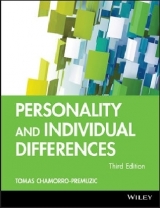
Personality and Individual Differences
John Wiley & Sons Ltd (Verlag)
978-1-4051-9927-8 (ISBN)
- Titel ist leider vergriffen;
keine Neuauflage - Artikel merken
Accompanying website featuring instructor material, further web resources and electronic versions of chapters Covers BPS syllabus for differential psychology Written by a rising star in the field of individual differences New full colour page design More real-life (and informal) examples 20% more figures and tables to use as study-tools and summaries Expanded sections on validity, temperament, creativity and hot intelligence New material on protective and non-psychometric tests
Tomas Chamorro-Premuzic is a Reader in Psychology at Goldsmiths, University of London, and visiting professor at NYU in London.
Preface to the Second Edition Preface to the First Edition Acknowledgments About the Author Chapter 1 Introducing Individual Differences - from Everyday to Psychological Questions 1.1 Introduction 1.2 Personality: A Commonsense Idea 1.3 Describing Individuals 1.4 Abnormality 1.5 Intelligence, Competition, and Adaptation 1.6 Predicting Success 1.7 Born Different? 1.8 Other Abilities 1.9 Variability and Change: Motivation and Mood States 1.10 Creativity 1.11 Leading the Way 1.12 Interests Chapter 2 Personality, Part I 2.1 Introduction 2.2 Overview and Approaches 2.3 Definition of Personality Traits 2.4 History of Personality 2.5 Personality Traits and States: Dispositional vs. Situational Approaches 2.6 Eysenck's Gigantic Three and the Biological Basis of Personality Traits 2.7 Self-Report Inventories 2.8 The Biological Basis of Personality 2.9 Gray's Personality Theory 2.10 Cattell's 16PF and the Lexical Hypothesis 2.11 The Five Factor Model (Big Five) 2.12 Summary and Conclusions Chapter 3 Personality, Part II - Validating Personality Traits 3.1 Introduction 3.2 Testing Personality Theories 3.3 Personality and Social Behavior 3.4 Personality and Romantic Relationships 3.5 Personality and Performance 3.6 Personality and Health 3.7 Personality and Happiness 3.8 Current Developments Outside the Dispositional Paradigm 3.9 Summary and Conclusions Chapter 4 Psychopathology 4.1 Introduction 4.2 Defining Abnormality 4.3 Historical Roots of Psychopathology 4.4 Modern Approaches to Psychopathology 4.5 Integrative Approaches to Psychopathology: The Biopsychosocial Model 4.6 Diagnosis: Classifying Psychological Disorders 4.7 Major Psychological Disorders 4.8 Criticisms of the Diagnostic Approach 4.9 Dimensional View of Psychopathology and Personality Disorders 4.10 Summary and Conclusions Chapter 5 Intelligence, Part I 5.1 Introduction 5.2 Defining Intelligence 5.3 History of Intelligence Testing 5.4 Cattell's Theory of Fluid and Crystallized Intelligence 5.5 Genetic vs. Environmental Causes of Intelligence 5.6 Piaget and the Developmental Theory of Cognitive Ability 5.7 The Great Debate: G vs. Multiple Abilities 5.8 Summary and Conclusions Chapter 6 Intelligence, Part II - Validating Intelligence and Correlates of IQ (Causes and Consequences) 6.1 Introduction 6.2 Wechsler's IQ Scale 6.3 Intelligence at School and University: Educational Outcomes 6.4 In the Job: Occupational Outcomes of Intelligence 6.5 Intelligence, Longevity, and Health 6.6 Intelligence and Social Class 6.7 Race and Sex Differences in IQ: Facts, Controversies, and Implications 6.8 Sex Differences in IQ 6.9 Even More Basic: Decomposing Intelligence 6.10 Summary and Conclusions Chapter 7 Behavioral Genetics 7.1 Introduction 7.2 Early Foundations of Behavior Genetics 7.3 DNA: Some Background 7.4 The Power of Genes: Recent Evidence for The Heritability of Intelligence 7.5 Intelligence and Assortative Mating 7.6 The Importance of the Environment 7.7 Biological Effects on Intelligence: Why Do they Increase Across the Lifespan? 7.8 Genetic Causes of Personality Traits 7.9 Genetic Basis of Maladaptive Behaviors 7.10 Personality and Intelligence: Interplay Between Environment and Genes? 7.11 Implications for Upbringing and Education 7.12 Contradicting Genetics: The Flynn Effect 7.13 Summary and Conclusions Chapter 8 Beyond IQ - Theories of Hot Intelligence 8.1 Introduction 8.2 Streetwise Rather than Book Smart 8.3 Early Beginnings: Thorndike's Social Intelligence 8.4 Theoretical Importance of Social Intelligence 8.5 Early Problems 8.6 Recent Approaches: From Multidimensionality to Implicit Theories 8.7 Emotional Intelligence 8.8 Debate and Controversy Surrounding Emotional Intelligence 8.9 Origins and Measurement Problems of EQ 8.10 Trait Emotional Intelligence: Emotional Self-Efficacy 8.11 Practical Intelligence 8.12 Summary and Conclusions Chapter 9 Mood and Motivation 9.1 Introduction 9.2 Beyond or Underneath Traits 9.3 Defining Motivation 9.4 From Biological Reflexes to Psychological Self-Realization 9.5 Mood States 9.6 Structure of Mood 9.7 Situational Determinants of Mood 9.8 Dispositional Influences on Mood States 9.9 Integrative and Recent Approaches to Mood States 9.10 Summary and Conclusions Chapter 10 Creativity 10.1 Introduction 10.2 Definitions and Conceptualizations of Creativity 10.3 Creativity Across Different Psychological Paradigms 10.4 Differential Approaches to Creativity 10.5 Creativity and Intelligence 10.6 Creativity and Personality Traits 10.7 Testing Creativity 10.8 Creativity in Different Fields (From Arts to Science) 10.9 Summary and Conclusions Chapter 11 Leadership 11.1 Introduction 11.2 Approaches to Leadership 11.3 Behavioral Approaches: Leadership Styles 11.4 Leadership and Gender 11.5 Summary and Conclusions Chapter 12 Vocational Interests 12.1 Introduction 12.2 Approaches to Vocational Interests 12.3 Linking Theory and Practice 12.4 Stability of Interests: Evidence for Dispositional Nature 12.5 Gender Differences in Vocational Interests 12.6 Person-environment Fit 12.7 Holland's Riasec Typology 12.8 Prediger's Three-Factor Model 12.9 Holland and the Big Five 12.10 Circumscription and Compromise: Gottfredson's Theory 12.11 Trait Complexes and Interests 12.12 Summary and Conclusions Glossary References Index
| Reihe/Serie | BPS Textbooks in Psychology |
|---|---|
| Zusatzinfo | col. ill |
| Verlagsort | Chichester |
| Sprache | englisch |
| Maße | 189 x 244 mm |
| Gewicht | 954 g |
| Einbandart | Paperback |
| Themenwelt | Geisteswissenschaften ► Psychologie ► Psychoanalyse / Tiefenpsychologie |
| ISBN-10 | 1-4051-9927-X / 140519927X |
| ISBN-13 | 978-1-4051-9927-8 / 9781405199278 |
| Zustand | Neuware |
| Haben Sie eine Frage zum Produkt? |
aus dem Bereich



